| Okay, maybe not
joy. Maybe... entertainment. Or education. Oh,
quit bellyaching. Just because you hate it doesn't
make it bad. If you liked swatching more, your
knits would fit better. Seriously. It's not a
swatch. IT'S A LITTLE YARNY CRYSTAL BALL THAT
WILL TELL YOU ALL KINDS OF STUFF. If you let it.
If you pay attention. If you quit hating it like
overcooked liver and onions.
I
have a theory. It's a heretical theory, but
I think it's fairly solid. Here it is: IF YOU
HATE SWATCHING, IT WILL NEVER WORK. Sound crazy?
Think about it. You're knitting away on a little
square you hate, all growling and intense and
wound up. You produce this tight little wad
of yarn which you measure (skipping the wash
because it takes too long) and use as a final
stitch count, snarling all the while. THEN you
happily start on your 'real' knitting, all relaxed
and happy and cruising along... is it any WONDER
the gauge swatch lied? Did it really lie, or
did you commit yarn abuse? (I bet the yarn has
a different view on it than you do.)
It's strange to me, that most
of the knitting world (at least the knitting
world I've been exposed to) hates swatching
with an intense and fiery passion. After all,
you learn so much from it. How does your yarn
handle? Is that cast-on going to work? Are you
in the neighborhood of the gauge you need for
a specific pattern? Is the color too bright?
Do those two colors look like crap together?
All this and more can be yours to know, if you
just suck it up, sit down, and knit yourself
a little square of fabric. You knit for fun
to begin with, don't you? So what's the problem?
When I first started knitting,
I hated to knit swatches too. Sometimes I skipped
it entirely. Things seldom, if ever, fit, and
once in a while I'd wind up with something so
stiff it could stand up by itself. (Cables.
Bulky yarn. Size seven needles. Not pretty.)
Hours and days and weeks and months of knitting,
unwearable, all because I wouldn't spend the
time to knit a stinking swatch. Then I started
designing my own patterns. Simple stuff, but
with yarn I liked on needles I wanted to use,
and I absolutely HAD to knit a swatch. I started
playing around with them; at first, it was just
shifting needle size for a more drapey, loose
fabric. Then it was throwing in color. Even
though my knitting was getting more complicated,
it was starting to fit a lot better. I was able
to predict final results, not only measurements,
but whether the sweater would hang the way I
wanted it to, if the colors would work, if a
certain technique would do what I wanted. Why?
Because I quit thinking of the swatch as a dreaded
first step, and began thinking of it as a practice
session.
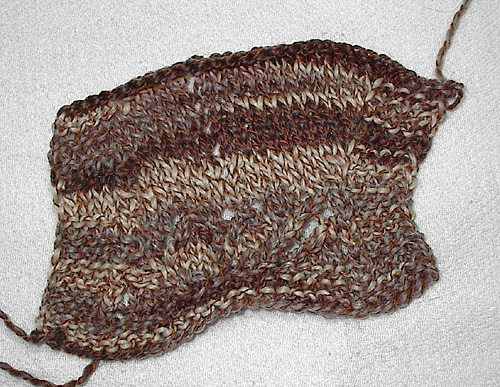
Here we've got a test swatch
for a wrap I'm going to knit. This is kind of
an original design, in that I'm going to make
up the pattern instead of reading it off of
something, but 'design' is an awfully glorified
term for knitting a rectangle. The bottom part
of the swatch is a garter stitch edge, then
a lace pattern with a five stitch garter edge.
The top half is biased knitting with a column
of faggoting through it. Let's look at what
I learned.
- The cast-on method works; it's stretchy
but not too loose, and it's unobtrusive, which
I wanted.
- Five stitches of garter stitch on the sides
are enough to keep them from curling around.
- Size five needles were too small for the
yarn; I switched to eights for the top half
and it worked much better. Wraps need drape,
which means loose knitting.
- The variegation is too busy for the lace
to be noticeable at all.
- The yarn, a roving with a binder thread,
splits a lot less than I'd expected and is
easy to work with.
- I don't like the biased idea.
- The faggoting works, and would look cool
with a colored ribbon wound through it.
- The yarn is striping itself, but with a
large width like a wrap, that should be avoided.
I'd do two rows with one ball of yarn and
then two rows with another, to make sure.
- Five minutes with a ruler and some pins
and I'll have the gauge figures I need to
get the wrap the size I want it.
- The cast off method works well, also. And
matches the cast on, which is a nice bonus.
- For what it's worth, I don't like the color,
but it's not for me so it doesn't really matter.
(Yes, colors shift between the ball and the
swatch; variegated yarns in particular can
look dramatically different in the ball.)
All that information, from
a little square it took less than an hour to
knit. What part am I supposed to hate, again?
Swatching is not a chore,
and it's not an absolute, and it's not a simple
step in a buy yarn-swatch-knit sweater process.
It's a tool. You use it to experiment, find
solutions, try out new ideas, or practice techniques
you will use to knit the project you have planned.
If it's a new stitch pattern, you need a few
practice runs before you relax and your gauge
gets consistent and your swatch has any accuracy
for you. If it's a yarn that's hard to work
with, it's the same general idea; you need time
to get used to it, to figure out the quirks
and how to cope with them, before your gauge
will settle down to something useful. Let me
repeat that: YOU NEED TO KNIT WITH THE YARN
A WHILE BEFORE YOU RELAX ENOUGH FOR THE GAUGE
TO BECOME ACCURATE. This is one of the major
reasons why large gauge swatches are more accurate
than small ones. You relax while knitting it.
Think of how many V-shaped swatches you've seen,
that started off tight and expanded as they
went. That's the reason why. You need to get
beyond the V shaped start, before the measurements
will do you any good at all.
Sometimes when you swatch,
what you learn is, you hate the yarn. That's
okay, too. If you only bought one ball of it,
for experimentation purposes, you can feel all
smug that you didn't blow the bucks for a whole
sweater's worth that you're now stuck with.
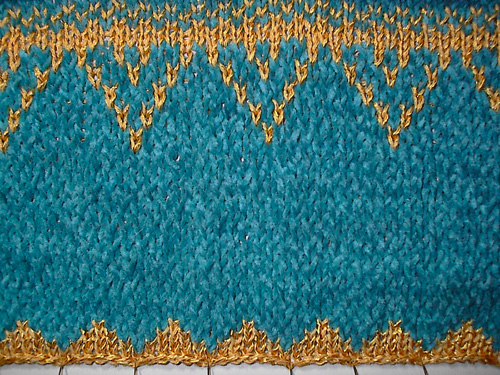
This was my attempt to imitate
gold stenciling on velvet. It is done with cotton
chenille (the blue-green) and rayon (the gold).
I think it's got potential; the shiny and matte
combination is kind of cool and I like it. But
the chenille and the rayon knit up at vastly
different gauges on the same needles, and for
now I've decided the whole thing is more trouble
than it's worth. Maybe some time in the future.
I only got one ball of each yarn; all that education
for almost no money or time. If I ever do decide
to knit up this idea, I've still got enough
yarn left for a lot more experimenting, to make
it work. (I also learned that I really freaking
hate chenille yarn.)
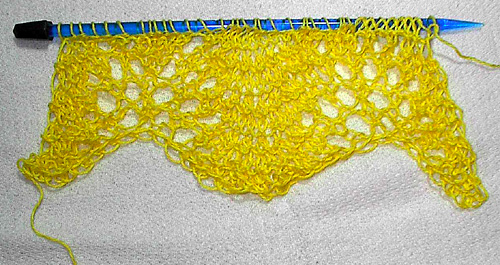
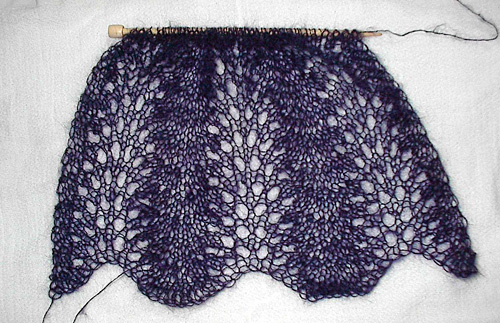
Want another example? Okay.
I want to knit some lace scarves with Doucer
et Soie (70% mohair, 30% silk, similar to Kid
Silk Haze) and I need a swatch. However. I don't
want to waste any of the yarn on a swatch, and
I've heard from many sources that mohair is
horrible to rip back and almost always looks
like a wet rat after you do it. Since it's for
a SCARF, I don't really need an exact gauge
figure, just a ballpark guess. So I used a similar
weight yarn to knit a couple pattern repeats
and see what was what. Turns out two pattern
repeats will produce a wide enough scarf, but
it's so thin and bunchable that I'm going to
use three, so that it will be wide enough to
put over a head, should that be desired. (If
I had guessed at it and cast on, I'd have gone
with four or more repeats and had something
like a lace bedspread.) Not exact, by any means,
but still educational. The yellow test swatch
is on the left, the blue final project is on
the right. Two repeats on the yellow, three
repeats on the blue.
There's a flip side to this
whole swatch deal. In a nutshell, your swatch
is the absolute and it's the pattern that you
adapt to it. (This is the complete opposite
of how you are taught to knit patterns.) Instead
of using patterns as an unchanging, concrete
formula, think of it as suggestions. It's how
one person produced the sweater you want to
copy. Often you can do a whole lot differently,
and still get a sweater that looks like what
you want. And why shouldn't you? It's your knitting,
not the pattern writer's.
Here, I give you Dale of Norway's
"Hafjell".
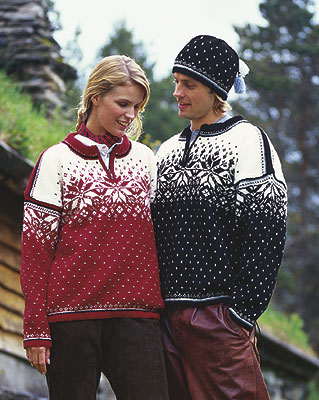
I love knitting Dale of Norway
sweaters. (I'm insane. What, like you didn't
know this?) Their gauges are very tight for
the yarn, producing solid, stiff fabric. I assume
this is to keep off the wind in those rough
Norwegian winters, and I get that, but the farthest
north I ever get is Ohio (southern edge of the
Great Lakes). What to do? Knit a swatch. Not
the one they tell you to. One that you like.
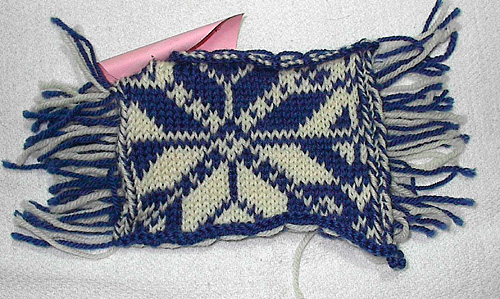
This was knit with needles
a size or two larger than is recommended for
the yarn (I know this because I labeled the
swatch when I knit it a year ago), and produces
a fabric I like the feel of. (Please note it's
knit in the round, just like the sweater was.
You've got to match your techniques.) The stitches
per inch count is off for the pattern, but that's
all right. You can tweak it with almost no math
involved. Honest.
My gauge with that yarn and
those needles is five and a half stitches to
the inch (suggested is six; that extra half
stitch really makes a difference). Now we look
at the pattern. The extra small version has
270 stitches around the chest. 270 stitches
at five and a half stitches per inch is 49 inches.
That's about the size I want, so I knit it up
using the numbers and directions for size extra
small. It won't BE an extra small, because my
gauge is different. But using the shaping and
numbers for an extra small will produce the
size I want at my gauge. PROPORTION NEVER CHANGES.
SIZE DOES. If you knit this sweater with sock yarn on size
1 needles, it would be proportionately correct
and probably fit a doll. The only drawback to
this is, if you're working with a larger gauge,
ALL the sweater sizes produced by the pattern
will be larger. But you can also make something
smaller by using a smaller gauge. There are
infinite possibilities. The world is your oyster.
The end result is this:
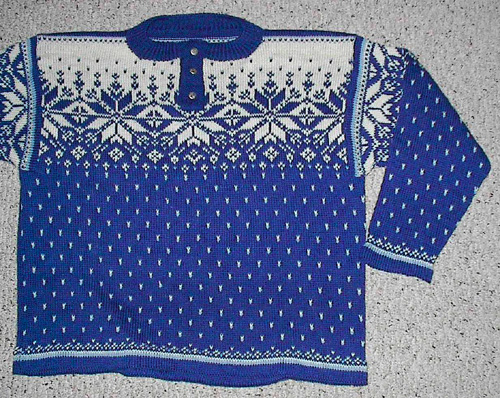
Just like the pattern. Well.
Except I set in the sleeves. And changed the
neck. And the hem. But I followed the pattern.
Honest.
I do this kind of thing all
the time; in fact, I can't remember the last
time I used the exact yarn and the exact gauge
suggested for a pattern. There is another Norwegian
design I want to knit for myself, with every
stitch charted, in a complex pattern. Every
size except medium has extra repeats, or not
enough, and looks strange. So instead of knitting
a size large at the gauge suggested and having
a weird looking sweater, I'm going to use a
thicker yarn at a larger gauge, and knit a size
medium that will fit me. See how this works?
It is not a natural law, that you have to match
your gauge to the pattern. But you have to know
what happens when you don't, and work with it.
I think that's the reason
so many people hate gauge swatches and knitting
them; they see a swatch as some absolute perfection
of numbers that they'll never attain, and of
course it's frustrating when you look at it
that way (who the heck gets 23 1/4 stitches
over four inches, or some of these other crazy
gauges??). So quit looking at it that way. Gauge
is nothing but a tool, to tell you what will
happen if you knit with that yarn on those needles.
If you like what your swatch is telling you,
who cares if it's exactly what the pattern says
you need? It's your project. Knit it your way.
There are, of course, a few
ways to make swatch knitting a little less nerve-racking
and annoying, even if you still hate them. My
number one method is to knit swatches while
working on other projects. I'm knitting a jacket
right now, but for an occasional break, I'll
work on a swatch for a project I'm planning
on starting in a month or two. Plus I did a
couple of the swatches for this article. (I
suspect this helps the relaxation factor; knit
after your hands are a little tired to keep
from being tightened up on the swatch.) You
can also buy random balls of yarn and knit up
swatches from them, just to see what happens.
If you like it, you can then find a pattern
(or make up your own), buy more yarn, and take
it from there. You have a far better idea what
you're getting into, that way. Or, stick with
one or two brands of yarn, never use anything
else, and you'll learn quickly exactly how it
behaves when you do all sorts of things with
it (I have begun using Brown Sheep's Lamb's
Pride Worsted for all felting projects. There
are no more ugly surprises.)
I hope this takes a little
of the stress out of swatch-knitting, and maybe
even injects some interest into it. (I suppose
enjoying it is still too much to ask.) Because
once you relax about it, your knitting really
is going to start fitting better. Lots of chocolate
helps, too.
You do realize, from here,
it's a teeny, tiny baby step to designing your
own knitwear, right?
NOTES:
Hafjell photo from www.allegroknits.com.
Pattern by Dale of Norway, available in booklet
#138. My version is knit with Heilo yarn in
colors 0020/cream, 5744/slate, and 5813/mist.
There are many intelligent
discussions on gauge by Elizabeth Zimmermann,
Debbie Newton, and Priscilla Gibson-Roberts,
if you're looking for additional reading.
Knitting in the Old Way by Gibson-Roberts
and Deborah Robson, and Knitting Without
Tears by Elizabeth Zimmermann are particularly
helpful.
All photos except
'Hafjell' taken by the author.
|

